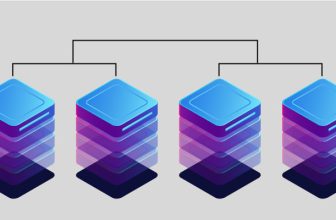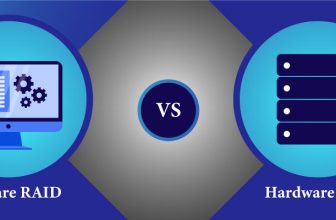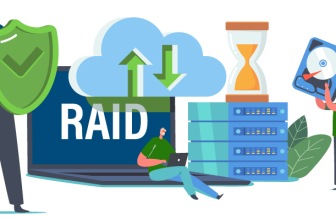A Comparison of Software and Hardware Raid

Introduction
RAID has always been the finest solution for providing fault tolerance and better storage management. It comes in many types, and each RAID type (0, 1, 2, 5, 6, 10) offers ample advantages for efficient data management.
How is RAID Important?
The main purpose of RAID is to improve the data redundancy. It protects the data in case of unexpected data losses and accidents, allowing users to retrieve the data without any downtime. RAID also helps in improving the performance of the workflows.
What is Hardware RAID?
The RAID that is implemented using a special controller is called the hardware RAID. This controller performs all the RAID operations without depending on the OS of the system.
How Does it Work?
In the hardware RAID configuration, the controller configures the logical disks, manages the array, and presents the data whenever needed.
Advantages of Hardware RAID
- Independent of the system’s OS.
- Offers great performance and is faster than software RAID.
- Does not demand more processing power.
- It has more RAID configuration options.
- Highly compatible with various operating systems.
- Provides more speed and space to read and write the data.
- Uses encryption mechanisms for data protection.
- Not vulnerable to viruses and malware.
Disadvantages of Hardware RAID
- Much more costly compared to that of the software RAID.
- Requires RAID replacement for maintaining configuration whenever the controller fails.
- Couldn’t meet the standard in a few large systems found in enterprise computing.
- Dependency on the RAID card performance can lead to occasional bottlenecks.
What is Software RAID?
The RAID that is implemented by an operating system is called the software RAID. Here all the storage drives are connected to the server or computer directly without the help of RAID controllers.
How Does it Work?
In the software RAID configuration, the data will be processed by the internal server. You should just connect the drives and configure them within your operating system in your host CPU.
Advantages of Software RAID
- Software RAID is much cheaper compared to hardware RAID.
- Users can easily reconfigure arrays without the controllers interrupting them.
- It supports more drives than the hardware RAID.
- Software RAID is highly used in large systems that are found in enterprise computing.
- Can serve the purpose entirely for modern server technologies.
Disadvantages of Software RAID
- Software RAIDs cannot perform as fast as hardware RAIDs.
- Imposes more strain on the server processing power.
- They can only support the selected OS and can’t comply with other operating systems.
- Replacement of the failed storage disk is very complicated in the software RAID condition.
- Consumes more processing power, which might affect the read and write speeds.
- RAID that is compatible with the selected OS cannot be installed in the system with another OS.
- Software RAID cannot support complex RAID levels.
- The software RAID performance is likely to suffer in the absence of a perfect algorithm.
Hardware RAID Vs Software RAID: Which One is Better?
Hardware RAID costs more than the software but offers many features that are worth spending money for. If you are compromised by budget, then go for software RAID. But if you can handle more investment, then prioritize the hardware RAID.
Conclusion
The type of RAID you choose has a great impact on your server storage performance. Both the hardware and software RAIDs have advantages and limitations to consider. So it is important that you consider all your options and select the RAID that can suit your budget and work requirements.






